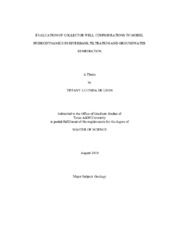Evaluation of Collector Well Configurations to Model Hydrodynamics in Riverbank Filtration and Groundwater Remediation
Abstract
Collector well designs are necessary to maximize groundwater uptake and riverbank filtration without negatively impacting an aquifer. Unfortunately, there is a lack of information and research regarding the implementation of collector well design parameters. In the past, collector well installation was too costly, but recent advances in well technology have made collector wells more cost effective. This research will contribute a set of guidelines to optimize riverbank filtration and groundwater remediation. This study models the hydrodynamics surrounding collector well configurations in riverbank filtration and groundwater remediation. Visual Modflow® was utilized to run a variety of numerical models to test four areas: flux along the laterals of a collector well, collector well interactions with a river, collector well yield, and collector well remediation capability. The two design parameters investigated were lateral length (25 m, 50 m, and 100 m) and number of laterals (3 and 4).
The lateral flux tests confirm flux increases towards the terminal end of each lateral and pumping rate is the controlling factor in flux amount obtained along the laterals. The analysis of the flux-river interaction shows the main factor in determining flux amount is the initial river geometry, followed by the pumping rate, regional background flow, and collector well design, respectively. The models suggest that the 4-lateral collector well design is more effective than the 3-lateral design and in addition, 100 meter length laterals provide the highest amount of yield with the least amount of drawdown. The remediation tests investigate the application of vertical well equations to evaluate collector well designs in two areas: minimum pumping rate to capture line source of particles and first arrival time of particles. The remediation models show 100 meter length laterals provide both the lowest pumping rate and the highest residence time with the surrounding aquifer for maximum remediation. Ultimately, these models provide basic design guidelines and explain which designs are most effective, depending on the collector well purpose.
Citation
De Leon, Tiffany Lucinda (2010). Evaluation of Collector Well Configurations to Model Hydrodynamics in Riverbank Filtration and Groundwater Remediation. Master's thesis, Texas A&M University. Available electronically from https : / /hdl .handle .net /1969 .1 /ETD -TAMU -2010 -08 -8244.


